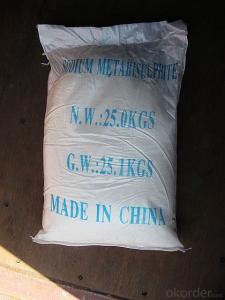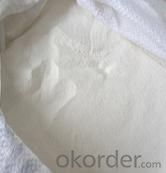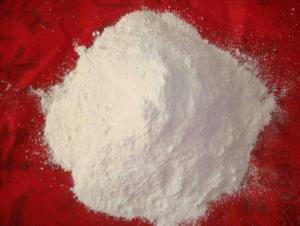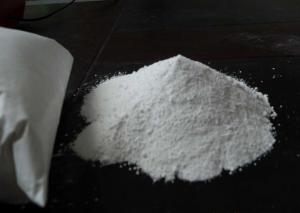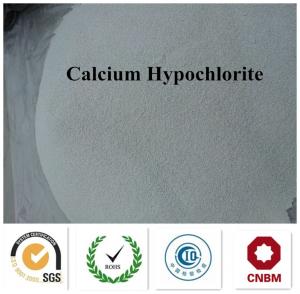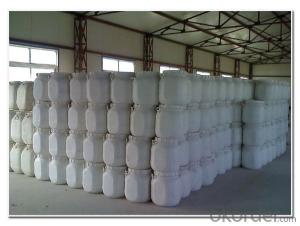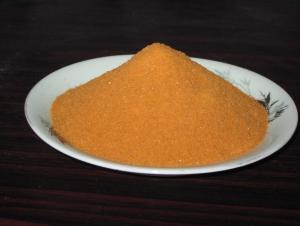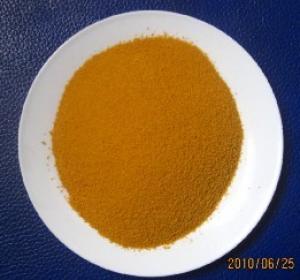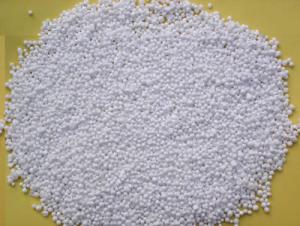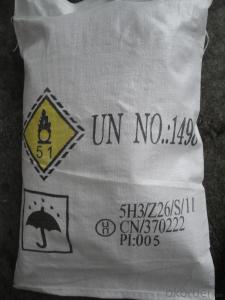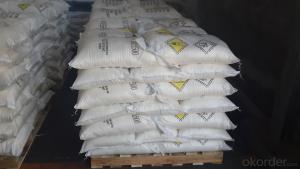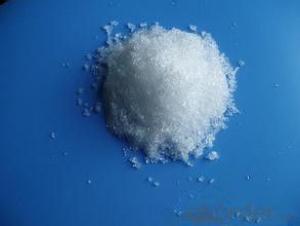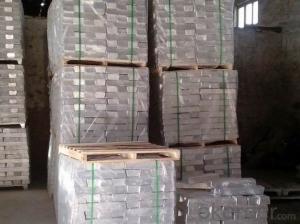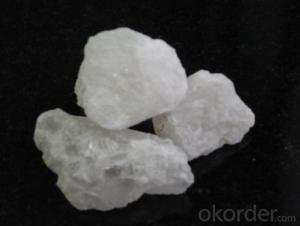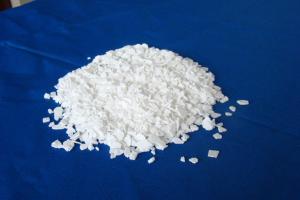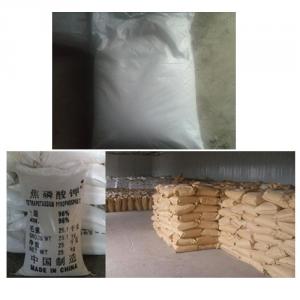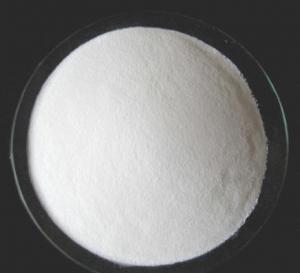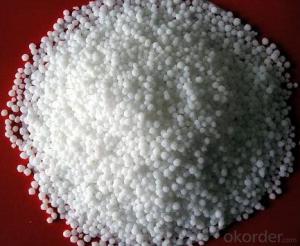INDUSTRY GRADE SODIUM METABISULFITE 97.2%
- Loading Port:
- Qingdao
- Payment Terms:
- TT OR LC
- Min Order Qty:
- 20 m.t.
- Supply Capability:
- 3000 m.t./month
OKorder Service Pledge
OKorder Financial Service
You Might Also Like
pecification For Food Grade and Industry Grade :
Item | Quality Index | |
Food Grade | Industry Grade | |
Purity ( As Na2S2O5) | 98.0% min | 96.0% min |
Sulfur Dioxide( SO2) | 65.0% min | 65.0% min |
Arsenic ( As ) | 0.0002% max | - |
Heavy metals ( As Pb ) | 0.0005% max | - |
Selenium (Se ) | 0.0005% max | - |
Iron (Fe) | 0.001% max | 0.002% max |
Water insoluble | 0.02% max | 0.05% max |
PH value : | 4.0-4.8 | 4.0-4.8 |
Remark : | Conformed with FCC V and E 223 Standard | |
Specification for Pharmaceutical Grade and Photo Grade
Item | Quality Index | |
Pharmaceutical Grade | Photo Grade | |
Purity ( As Na2S2O5) | 98.0% min | 98.0% min |
Sulfur Dioxide( SO2) | 65.0% min | 65.0% min |
Thiosulphate ( As S2O3) : | 0.05 % max | 0.05% max |
Chloride ( As CL-) : | 30 ppm max | 50ppm max |
Arsenic ( As ) : | 1ppm max | 1ppm max |
Lead ( Pb ) : | 1 ppm max | 2ppm max |
Copper (Cu) : | 1 ppm max | 1ppm max |
Iron (Fe ) : | 5 ppm max | 5ppm max |
Mercury (Hg) : | 0.1ppm max | 1ppm max |
Chromium (Cr) : | 1 ppm max | - |
Selenium (Se ) : | 1 ppm max | 5ppm max |
Zinc (Zn) | 1 ppm max | 1ppm max |
Cadmium (Cd ) | 1ppm max | - |
Nickel (Ni) | 1ppm max | - |
Na2SO3 + Na2SO4 | 1.5% max | - |
PH value : | 4.0-4.8 | 4.0-4.8 |
Remark : | Conformed with USP standard | |
Application:
(1) Food Grade: Bleach agent (e.g. candies, cake, bamboo shoots, etc); Loose agent (e.g. bread, cracker etc); Antiseptic and germicide (e.g. fruit juice, tinned food, brews, the cereals food is defended storage etc); Inhibitor and freshen agent (e.g. day lily, seafood, fruit and vegetable etc).
(2) Industry Grade: Mordant of printing and dyeing; Dechlorinate of textile after bleaching; Sulphonated agent and reducer of chemical industry and pharmacy; Bleach of paper pulp, bamboo and timber bleach of Stap; Treatment agent of waste water; Rubber solidifying agent Perfume industry is served as hydro carbon perfume aldehyde
The hide profession employ to do to molt dose and pliable dose and wearproof dose; sewage treatment, and so on .
(3) Pharmaceutical Grade: In chemical synthesis in the production of acrylic fibre, vitamin K, vitamin A, pharmaceutical intermediates, etc.
(4) Photo Grade: The sensitize industry is served as the developing agent reductant and the protection of fixing bath dose.
Storage: Store the product in a dry and cool place.
- Q: What is the inorganic salt
- Inorganic salts are inorganic compounds in the salt, formerly known as minerals, the body has been found in more than 20 species, including constant elements of calcium, phosphorus, potassium, sulfur, sodium, chlorine, magnesium, trace elements are iron, zinc, , Chrome, cobalt, iodine, etc. If you pay attention to diet diversification, eat less animal fat, eat brown rice, corn and other coarse grains, do not eat too much refined flour, the body can make the inorganic salt to maintain normal level.
- Q: People do not eat salt tears with no inorganic salt
- Your body depends on sodium ions for a variety of regulation, including the transmission of nerve signals, etc., before you tears do not contain salt before you have a dog
- Q: Why inorganic salt waterproof coating does not apply to roof waterproofing
- Inorganic salts are generally in the form of waterproof agent, generally mixed with cement quality of 3-5 percent, Jiangxi Nanchang rhyme waterproof material factory
- Q: What are the important physiological functions of inorganic salts in cells
- As a result of metabolism, every day a certain amount of inorganic salts from a variety of ways out of the body, which will be added through the diet. The metabolism of inorganic salts can be judged by analyzing the concentration of blood, hair, urine or tissue. The role of inorganic salts in the human body is interrelated. In the appropriate concentration range beneficial to the health of people and animals and plants, lack or too much can cause disease, and disease and affect its metabolism, often increase its consumption. In China, the lack of calcium, iron and iodine is more common. Selenium, fluoride and other geochemical environment with the different, both the lack of disease such as Keshan disease and Kashin-Beck disease, teeth, etc., there are too many diseases such as fluorosis and selenium poisoning.
- Q: List the major electrolytes released by inorganic salts when placed in water and explain how these electrolytes are needed for metabolic reactions.
- Which "inorganic salts" are you talking about? There are hundreds!
- Q: Cells are composed of water and inorganic salts or by organic matter and none
- There are, but the water accounted for most of the inorganic salt to maintain cell acid and alkali balance;
- Q: Common inorganic salt ions will appear when the corresponding symptoms
- Iodine: goiter, mental and physical development disorders
- Q: What is the disease of inorganic salt crystals?
- It is recommended to drink boiled water.No need to take medication.
- Q: What are the effects of water, inorganic salts, carbohydrates, proteins, fats and vitamins?
- The main physiological functions of carbohydrates (also known as carbohydrates): 1. Supply of heat. (Per gram of sugar can release 4 kcal of calories, is the main source of heat the body.) 2. constitute the body tissue. (All the nerve tissue, cells and body fluids are still carbohydrates.) 3. Can help the oxidation of fat to help the liver detoxification, promote growth and development.
- Q: RO reverse osmosis water machine can remove impurities in the water, that the body will not be due to lack of minerals and malnutrition?
- Modern people generally nutrient surplus, not because of the lack of minerals in the water and hurt, there is no such a report in medicine, Moreover, the world's drinking water into million, have been for decades, not because of water No minerals and malnutrition. The human body will not be due to trace minerals in the water and particularly strong, as long as the nutritional balance like the American Medical Journal (American Medical Journal) pointed out: the human body needs minerals from food, Not from drinking water.
Send your message to us
INDUSTRY GRADE SODIUM METABISULFITE 97.2%
- Loading Port:
- Qingdao
- Payment Terms:
- TT OR LC
- Min Order Qty:
- 20 m.t.
- Supply Capability:
- 3000 m.t./month
OKorder Service Pledge
OKorder Financial Service
Similar products
Hot products
Hot Searches
